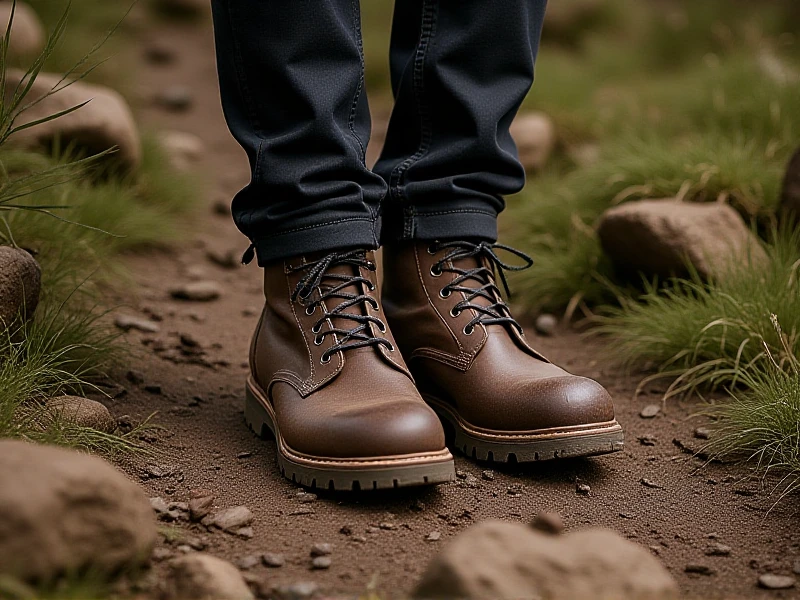
2025-09-02
Here is an SEO-optimized article focused on "Work boots":
Your feet are your foundation, especially on the job. Whether you're navigating construction sites, handling factory equipment, landscaping, or working long shifts on hard floors, the right work boots are non-negotiable. They're not just footwear; they're essential safety equipment protecting you from countless potential hazards. Choosing wisely impacts your safety, comfort, and productivity all day long.
Safety First: Understanding Standards and Protection
The primary job of work boots is safeguarding your feet. Look for boots meeting relevant safety standards for your trade, such as ASTM (ASTM F2413) standards in the US. Key protective features include:
- Protective Toe Caps: Steel, composite, or aluminum toes shield your feet from falling objects or compression. Consider the weight and safety requirement differences.
- Puncture-Resistant Soles: Crucial for construction, waste management, or any environment with sharp debris on the ground like nails or metal shards. PR ratings indicate this protection.
- Electrical Hazard Protection (EH): Insulated soles to reduce the risk of electric shock in environments with live circuits, common in utilities and electrical work. (Note: EH boots offer secondary protection, not primary insulation.)
- Slip Resistance: Work boots with specially designed, oil- and chemical-resistant outsoles are vital to prevent dangerous falls on slippery surfaces.
Material & Construction: Built for Durability
Quality work boots are an investment. Key construction aspects are:
- Upper Materials: Full-grain leather offers legendary durability, weather resistance, and breathability. Suede and tough synthetic fabrics offer lighter options or enhanced flexibility. Look for abrasion and water resistance based on your environment.
- Welt Constructions: Goodyear welt construction is famous for extreme durability, water resistance, and being resolvable, extending boot life. Cement construction is often lighter weight.
Essential Comfort Technologies
Protection means nothing if the boots are unwearable! Comfort technologies prevent fatigue:
- Advanced Cushioning & Support: EVA midsoles, polyurethane insoles, or dedicated cushioning foams absorb impact and reduce foot fatigue significantly over long hours.
- Arch Support: Proper built-in arch support promotes stability and reduces strain on feet, knees, and back. Removable insoles let you use orthotics.
- Breathable Linings: Fabrics like mesh or moisture-wicking materials prevent excessive sweating and discomfort.
- Ankle Support: Higher boots provide crucial stability and prevent twists on uneven terrain, a key feature for demanding jobs.
Finding Your Perfect Pair
Don't settle! Prioritize fit – try boots on later in the day when feet are slightly swollen. Wear the socks you'll work in. Walk around and ensure ample toe room and no painful pressure points. Consider the specific hazards and demands of your job site to select the right safety certifications and features. Finally, remember that quality work boots are protective gear designed to last. Investing wisely ensures you stay comfortable, protected, and productive shift after shift. Make safety your foundation with dependable work boots.
Here is an SEO-optimized article focused on "Work boots":
Your feet are your foundation, especially on the job. Whether you're navigating construction sites, handling factory equipment, landscaping, or working long shifts on hard floors, the right work boots are non-negotiable. They're not just footwear; they're essential safety equipment protecting you from countless potential hazards. Choosing wisely impacts your safety, comfort, and productivity all day long.
Safety First: Understanding Standards and Protection
The primary job of work boots is safeguarding your feet. Look for boots meeting relevant safety standards for your trade, such as ASTM (ASTM F2413) standards in the US. Key protective features include:
- Protective Toe Caps: Steel, composite, or aluminum toes shield your feet from falling objects or compression. Consider the weight and safety requirement differences.
- Puncture-Resistant Soles: Crucial for construction, waste management, or any environment with sharp debris on the ground like nails or metal shards. PR ratings indicate this protection.
- Electrical Hazard Protection (EH): Insulated soles to reduce the risk of electric shock in environments with live circuits, common in utilities and electrical work. (Note: EH boots offer secondary protection, not primary insulation.)
- Slip Resistance: Work boots with specially designed, oil- and chemical-resistant outsoles are vital to prevent dangerous falls on slippery surfaces.
Material & Construction: Built for Durability
Quality work boots are an investment. Key construction aspects are:
- Upper Materials: Full-grain leather offers legendary durability, weather resistance, and breathability. Suede and tough synthetic fabrics offer lighter options or enhanced flexibility. Look for abrasion and water resistance based on your environment.
- Welt Constructions: Goodyear welt construction is famous for extreme durability, water resistance, and being resolvable, extending boot life. Cement construction is often lighter weight.
Essential Comfort Technologies
Protection means nothing if the boots are unwearable! Comfort technologies prevent fatigue:
- Advanced Cushioning & Support: EVA midsoles, polyurethane insoles, or dedicated cushioning foams absorb impact and reduce foot fatigue significantly over long hours.
- Arch Support: Proper built-in arch support promotes stability and reduces strain on feet, knees, and back. Removable insoles let you use orthotics.
- Breathable Linings: Fabrics like mesh or moisture-wicking materials prevent excessive sweating and discomfort.
- Ankle Support: Higher boots provide crucial stability and prevent twists on uneven terrain, a key feature for demanding jobs.
Finding Your Perfect Pair
Don't settle! Prioritize fit – try boots on later in the day when feet are slightly swollen. Wear the socks you'll work in. Walk around and ensure ample toe room and no painful pressure points. Consider the specific hazards and demands of your job site to select the right safety certifications and features. Finally, remember that quality work boots are protective gear designed to last. Investing wisely ensures you stay comfortable, protected, and productive shift after shift. Make safety your foundation with dependable work boots.